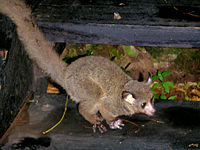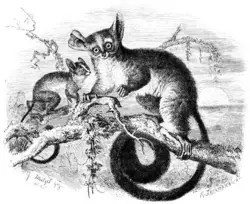Galago
| Galagos[1] | ||||||||||||||
|---|---|---|---|---|---|---|---|---|---|---|---|---|---|---|
 Brown greater galago (Otolemur crassicaudatus)
| ||||||||||||||
| Scientific classification | ||||||||||||||
| ||||||||||||||
|
Otolemur |
Galago, or bushbaby (bush baby), is the common name for any of the relatively small, African prosimian primates comprising the family Galagidae, characterized by a long, often bushy tail, large eyes, hindlimbs considerably longer than forelimbs, and all digits of the feet and hands bearing nails. On occasion they are placed within the Lorisidae (or Loridae) family as a subfamily. They also are known as nagapies, or "little night monkeys," in Afrikaans. Galagos are found only in Africa, but are widely distributed on that continent.
Overview and characteristics
Galagos are memberrs of the taxon Strepsirrhini, which is one of the two suborders of primates, and one that also includes the prosimians known commonly as lemurs, lorises, pottos, and Aye-aye. Members of Strepsirrhini are known for their "wet noses," referring to the presence of the rhinarium, a wet, naked surface around the nostrils of the nose, such as found in most mammals, but lacking in the other primate suborder, the Haplorrhini. The Strepsirrhini (non-tarsier prosimians) also are called "curly-nosed" primates while the Haplorrhini (tarsiers, monkeys and apes) are known as "simple-nosed" primates.
Galagos have tails that are always long relative to the body and generally is bushy. The eyes are relatively large, round, and are oriented obliquely forward. They have a reflecting layer (tapetum lucidum) behind the retina that aids night vision. The ears are moderate to large in size, membraneous, and can be folded in the fashion of a concertina or accordion. The hindlimbs are significantly longer than the forelimbs. They have nails on all digits, although the second toe of the hindfoot bearing an elongated nail, or "grooming claw," that is angled away from the dorsal surface (Martin 2004).
Galagos have pectinate ("comb-like") incisors, with the crows of the four incisors and two canines angled forward to form a dental comb that serves both for feeding and grooming. There are 36 total teeth, and the dental formula:
| 2.1.3.3 |
| 2.1.3.3 |
The eyes are adapted to give them good night vision, their hearing is acute, and the long tails give them good balance.
According to some accounts, the name bush baby comes from either the animal's cries or appearance. The South African name nagapie, or "little night monkey," comes from the fact they are almost exclusively seen at night.
Behavior, diet, and reproduction
Galagos are typically nocturnal and arboreal. Most are agile leapers and run swiftly along branches, and some species can leap several meters between supports and exhibit bipedal hopping on the ground. Some leap rarely and some are mainly quadrupedal (Martin 2004).
Their diet is a mixture of arthropods (mainly insects) and other small animals, fruit, and tree gums (Charles-Dominique 1984). Species with larger size tend to be more frugivorous and species with smaller size tend to be more insectivorous. Euoticus species, the needle-clawed galagos, specialize in feeding on tree gums (Martin 2004). Most species are solitary foragers (Martin 2004).
Galagos are polygamous and give birth typically to a single infant, although some species commonly produce twins, and there can be triplets as well (Martin 2004). After a gestation period of 110-133 days, young galagos are born with half-closed eyes and are initially unable to move about independently. After a few days (6-8 days), the mother carries the infant in her mouth, or it clings to her fur in some species, and places it on branches while feeding.
Galagos live in social networks of some sort. Females maintain their territory but share them with their offspring. Males leave their mothers' territories after puberty but females remain, forming social groups consisting of closely related females and their young. Adult males maintain separate territories, which overlap with those of the female social groups; generally, one adult male mates with all the females in an area. Males who have not established such territories sometimes form small bachelor groups (Charles-Dominique 1984).
Galagos communicate both by calling to each other, and by marking their paths with urine. At the end of the night, group members use a special rallying call and gather to sleep in a nest made of leaves, a group of branches, or a hole in a tree.
Reports from veterinary and zoological sources indicate captive lifetimes of 12 to 16.5 years, suggesting a natural lifetime of the order of a decade.
Classification
There has been much recent study of the Galagidae. Several new species have been discovered, and they are now grouped into three genera, with the two former members of the now defunct genus Galagoides returned to their original genus Galago: [1]
- ORDER PRIMATES
- Suborder Strepsirrhini: non-tarsier prosimians
- Family Cheirogaleidae: dwarf and mouse lemurs
- Family Lemuridae: lemurs
- Family Lepilemuridae: sportive lemurs
- Family Indriidae: wooly lemurs and allies
- Family Daubentoniidae: Aye-aye
- Family Lorisidae: lorises, pottos and allies
- Family Galagidae: galagos, or bushbabies
- Genus Otolemur : greater galagos, or thick-tailed bushbabies
- Genus Euoticus : needle-clawed bushbabies
- Genus Galago : lesser galagos, or lesser bushbabies
- Suborder Haplorrhini: tarsiers, monkeys and apes
- Suborder Strepsirrhini: non-tarsier prosimians
Genomics
A low-coverage genomic sequence of the Northern Greater Galago, Otolemur garnettii, is in progress. As it is a 'primitive' primate, the sequence will be particularly useful in bridging the sequences of higher primates (macaque, chimp, human) to close non-primates such as rodents. The 2x planned coverage will not be sufficient to create a full genome assembly, but will provide comparative data across most of the human assembly.
Notes
- ↑ 1.0 1.1 C. Groves, "Galagidae," pages 123-127 in D. E. Wilson and D. M. Reeder, eds., Mammal Species of the World, 3rd edition. (Johns Hopkins University Press, 2005). ISBN 0801882214.
ReferencesISBN links support NWE through referral fees
[1].
Groves, C. 2005. Galagidae. Pages 123-127 in D. E. Wilson and D. M. Reeder, eds., Mammal Species of the World, 3rd edition. Johns Hopkins University Press. ISBN 0801882214.
Martin
External links
| Extinct primate families by suborder |
|---|
| Strepsirrhini: Cheirogaleidae · Lemuridae · Lepilemuridae · Indriidae · Daubentoniidae · Lorisidae · Galagidae
Haplorrhini: Tarsiidae · Cebidae · Aotidae · Pitheciidae · Atelidae · Hylobatidae · Hominidae · Cercopithecidae |
Template:Galagidae nav
Credits
New World Encyclopedia writers and editors rewrote and completed the Wikipedia article in accordance with New World Encyclopedia standards. This article abides by terms of the Creative Commons CC-by-sa 3.0 License (CC-by-sa), which may be used and disseminated with proper attribution. Credit is due under the terms of this license that can reference both the New World Encyclopedia contributors and the selfless volunteer contributors of the Wikimedia Foundation. To cite this article click here for a list of acceptable citing formats.The history of earlier contributions by wikipedians is accessible to researchers here:
The history of this article since it was imported to New World Encyclopedia:
Note: Some restrictions may apply to use of individual images which are separately licensed.
- ↑ Charles-Dominique, Pierre (1984). in Macdonald, D.: The Encyclopedia of Mammals. New York: Facts on File, 332–337. ISBN 0-87196-871-1.

